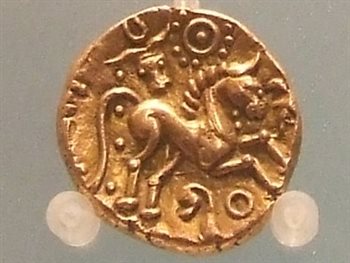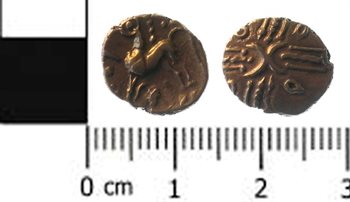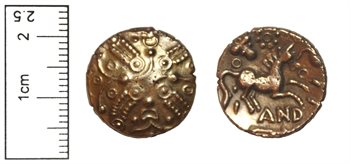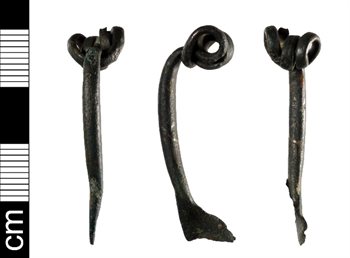Cranfield in Prehistory
This page was written by Sally Williams, Derry Young, Paul and Dawn Jeffery

A reconstruction of an Bronze Age round house at Flag Fen October 2011
Early Man in Cranfield
Little is known of the prehistory of the area that was later to become Cranfield. Archaeological surveys undertaken prior to construction works have discovered some limited evidence of prehistoric occupation: two undated inhumations on the land now occupied by the Home Farm development off the High Street/Lodge Road that may prove to be prehistoric, one being a crouched burial which has been removed and a second which remains in the ground undisturbed. [HER 13418]
This site has also revealed pottery, flint and quartz artefacts dating from the late Bronze Age to early Iron Age [Document: 2005/37 Project: HFC 1094 Albion Archaeology]
Archaeological exploration of land to the south-east of Cranfield airfield has uncovered evidence of activity of early man consisting of flint artefacts: a blade, a flake and a side scraper together with a single sherd of pottery. These have been dated as being between the early Neolithic and late Bronze Age periods 4000 - 701 BC. [HER 11866]
A route of prehistoric origins may be represented by the trackway which is followed by the boundary between Stagsden and Kempston Rural parishes, and enters Cranfield as the bridleway north of Hillgreen Farm.

Tasciovanus Iron Age gold stater circa 20 BC Image acknowledgement: Higgins Art Gallery and Museum Bedford
The Iron Age 800BC – 43 BC
There is much evidence of Iron Age occupation and it is evident that at this time a recognisable settlement was present where parts of the current village now stand.
On the Home Farm site, a number of round houses have been identified from the eaves drip gullies. These houses dates from a number of periods, suggesting occupation over an extended period and are generally 8 to 8.5 m diameter. [HER 13418]
Two lines of post holes have been identified that may represent a fence. Three pits containing burnt cobbles/stones were perhaps used for cooking. A number of ditches probably used as enclosures and quantities of late Iron Age pottery have been found. Two un-urned cremations have been found, one associated with a timber nail that may have been part of the funeral pyre.
The airfield site has also produced a wealth of evidence from the Iron Age. Pits, ditches, post holes and significant quantities of pottery suggest settlements and agriculture. Large quantities of mammal bones, a small amount of bird bones and non-marine mollusc shells show what the diet might have contained for these early residents.
A very significant find is a gold coin, a stater, of the late Iron Age from the Celtic period of Tasciovanus, king of the Catuvellauni c. 20 BC. He ruled from his base in modern day Saintt Albans and is thought to have had strong links to Belgic Gaul, where he probably encountered coinage and became the first native British king to mint coins. The coin was found in the Broad Green area of the village. The coin, at the head of this section, is now on display in the Higgins Art Gallery and Museum Bedford.

A gold stater from Cranfield. Images acknowledgement: Portable Antiquities Scheme Database/The Trustees of the British Museum
Two further coins from the reign of Tasciovanus have come to light in Cranfield. A second gold stater found near Leys Farm and a copper alloy coin. These coins were returned to their finders after cataloguing.

Andoco Iron Age gold stater circa 20-10 BC. Image acknowledgement: Portable Antiquities Scheme Database/The Trustees of the British Museum
Another Iron Age gold stater of Andoco was found near Conns Farm. This is a British Eastern coin of the Trinovates, dating to c. 20 BC - AD 10. The reverse shows a horse right inscribed below: AND. The obverse shows a cross. Weight is 5.51 grammes, diameter is 18.9 millimeters.
South of Brook Farm, two late Iron Age/Roman brooches have been found. One is described as: An incomplete copper-alloy Nauheim-derivative brooch, dating from the Late Iron Age to Early Roman period. The brooch has been made in one piece. The arched bow is of low triangular section, the central ridge on the upper surface flanked by a pair of parallel perimeter grooves. At the top, the bow angles inwards, extending into the circular-sectioned spring. Most of the spring's three original coils remain, as does the internal chord, but the pin is missing. The lower bow and foot have also been lost in antiquity. Length: 34.1 millimeters; width (head): 9.9 millimeters; weight: 2.1 grammes.

Late Iron Age/early Roman brooch found near Brook Farm. Image acknowledgement: Portable Antiquities Scheme Database/The Trustees of the British Museum
The second brooch is an incomplete copper-alloy Nauheim-derivative brooch, dating from the Late Iron Age to Early Roman period. The brooch has been made in one piece. The arched bow is of oval section, tapering towards the flattened foot with damaged catch-plate. The top of the bow bends downwards at 90 degrees, extending into the four spring coils and internal chord that make up the head. The pin has been lost in antiquity. A dark, almost black, patina coats the surface of the brooch. Length: 37.5 millimeters; width (head): 10.3 millimeters; weight: 3 grammes.